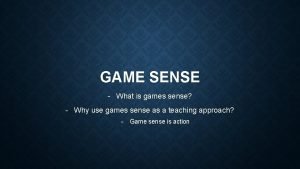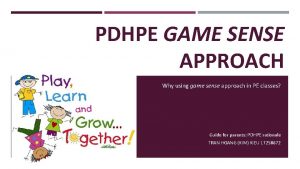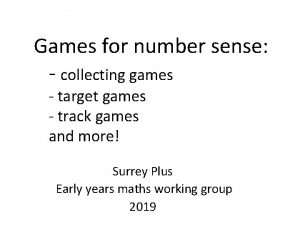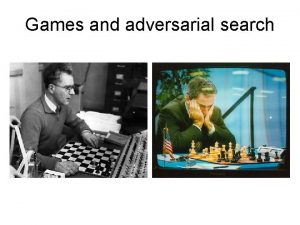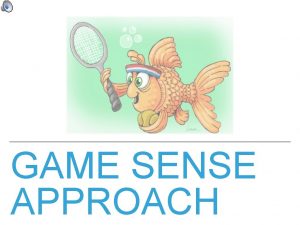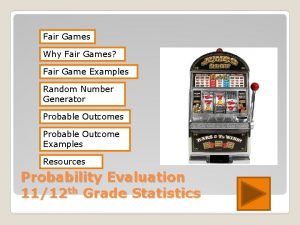GAME SENSE What is games sense Why use







- Slides: 7

GAME SENSE - What is games sense? - Why use games sense as a teaching approach? - Game sense is action

GAME SENSE • Game sense, or Teaching Games for Understanding, is a fairly new theory which has been placed into pedagogies for just over 30 years. • It implies that the traditional skill-and-drill approach no longer works. And works on the notion of allowing kids to “develop thinking through problem solving using physical activity” (Pill, 2008 p. 1) • It is a holistic approach to teaching the skills, and overall movement skills, within a game layout while allowing ”the participant in situations where decision making and problem solving are central to successful performance” (ibid p. 1)

WHY IT IS GOOD FOR CHILDREN, TEACHERS, AND PARENTS. • “All we see is kids having a great time, discovering for themselves new and complex skills of evasion, team work, rules, spatial awareness – and … some tactics. ” – (Townsend, 1) • “In the playground, participation is success; by all means play to win, but better play and lose than not play at all in this valuable ‘free time’. (ibid, 1) a. Game sense makes use of this theory (Mandigo et al. ) • “the … ‘game sense’ approach is the way forward” (Townsend, 2)

SYLLABUS LINKS • Covers some of the syllabus skills which are essential for students to be able to: a. Communicate confidently in a variety of situations (COS 3. 1) b. Acts in ways that enhance the contribution of self and others in a range of cooperative situations (INS 3. 3). c. Refine and apply movement skills creatively to a variety of challenging situations (MOS 3. 4). d. Shows how to maintain and improve the quality of an active lifestyle (ALS 3. 6). e. Performs a range of dance styles and sequences confidently (DAS 3. 7). f. Applies movement skills in games and sports that require communication, cooperation, decision making, and observation of rules (GSS 3. 8). g. Demonstrates coordinated actions of the body when performing gymnastic sequences (GYS 3. 10).

GAME SENSE AS A TEACHING TOOL • As a teaching and pedagogical planning tool a. Allows for more inter-student and teacher-student interaction, due to the exploratory and problem solving nature of the approach. b. Allows teachers to educate their students about basic and complex movement skills as wells as allowing the students their constructed ‘free play’ time c. Allows teachers to plan activities over both a short and long period of time depending on the movement skill sets required for the sport the wish to teach. (Medwell, 2010; Meldrum & Peters, 2012).

EXAMPLES OF GAME SENSE IN ACTION • Basketball (original game): two opposing teams play on a court. Students move freely but can not run whilst holding the ball, they must dribble the ball for no more than 5 seconds. A point is awarded to the team who scores by throwing the ball into the basketball net. • Basketball [pivot and step: Modification #1]: All the rules are the same bar the movement skills. This skill is modified to one similar to netball rules. Players must pivot and may take one step before passing to another teammate. • Basketball [2 steps NRL pass: modification #2] all rules are nce again the same, bar the movement and passing skills. Students are now allowed to take two running steps before passing it to their chosen teammate. However, rather than using basketball/netball throwing and catching skills, they must use the rugby throwing and catching skills.

REFERENCES • Board of Studies, NSW. (2007). Personal development, health and physical education K-6: Syllabus. Sydney, Australia: Author. • Light, R. (2006). Game sense: Innovation or just good coaching? Journal of Physical Education New Zealand, 39(1), 8 -19, 3. • Mandigo, J. , Butler, J. , & Hopper, T. (2007). What is teaching games for understanding? A Canadian perspective. Physical & Health Education Journal, 73(2), 14 -20. • Medwell, J. (2010). Approaching long-and medium-term planning. In J. Arthur & T. Cremin (Eds. ), Learning to teach in the primary school (2 nd ed. , pp. 96 -105). New York, NY: Routledge. • -- Approaching short-term planning. In J. Arthur & T. Cremin (Eds. ), Learning to teach in the primary school (pp. 106 -117) • Meldrum, K. , & Peters, J. (2012). Program planning in physical education. In Learning to teach health and physical education: The student, the teacher and the curriculum (pp. 232 -251). Frenchs Forest, Australia: Pearson • Pill, S. (2008). Teaching games for understanding. Sport Coach, 29(2).
